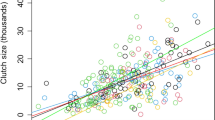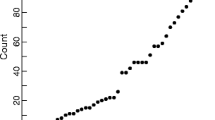Abstract
Identifying factors that affect demographic parameters and how those factors act is vital for understanding population dynamics, especially of endangered species. Moreover, specific ideas in the population dynamics of large herbivores underpin the management of the critically endangered black rhinoceros (Diceros bicornis). We studied an expanding black rhinoceros population since its establishment in 1986 in the Great Fish River Reserve, South Africa, through 2008 when managed removals interrupted natural dynamics. During the study, only 13 animals died, of which nine were subadults. In a linear modelling context, we used information-theoretic methods to evaluate the influence of independent variables expected to affect demographic parameters. For females, age at first reproduction (AFR) increased with abundance, but there was no effect of abundance on adult fecundity as measured by inter-birth intervals (IBIs). We evaluated these results in the theoretical context of population dynamics of large herbivores, in particular, Eberhardt’s proposal of a specific sequence in which demographic parameters first respond to increasing density. Our observations are consistent with Eberhardt’s prediction that immature individuals are impacted before adults, but the relative timing and magnitude of density effects on immature individuals was unclear. Rainfall did not influence AFR or IBIs. Maternal age influenced IBIs but much of the observed variation in IBIs was not accounted for by structural variation. Studies of populations more nearly approaching a stable age distribution and carrying capacity are needed to resolve remaining uncertainties and ambiguities in the life history of the black rhinoceros in particular and megaherbivores in general.


Similar content being viewed by others
Explore related subjects
Discover the latest articles and news from researchers in related subjects, suggested using machine learning.References
Bonenfant C, Gaillard J-M, Coulson T, Festa-Bianchet M, Loison A, Garel M, Loe LE, Blanchard P, Pettorelli N, Owen-Smith N, du Toit J, Duncan P (2009) Empirical evidence of density-dependence in populations of large herbivores. Adv Ecol Res 41:313–357
Brodie JF, Muntifering J, Hearn M, Loutit B, Loutit R, Brell B, Uri-Khob S, Leader-Williams N, du Preez P (2011) Population recovery of black rhinoceros in north-west Namibia following poaching. Anim Conserv 14:354–362
Bronson FH (1989) Mammalian reproductive biology. University of Chicago Press, Chicago
Burnham KP, Anderson DR (2002) Model selection and multimodel inference: A practical information-theoretic approach, 2nd edn. Springer, New York
Converse SJ, White GC, Block WM (2006) Small mammal responses to thinning and wildlife in ponderosa pine-dominated forests of the southwestern United States. J Wildl Manag 70:1711–1722
De’ath G, Fabricius KE (2000) Classification and regression trees: a powerful yet simple technique for ecological data analysis. Ecology 81:3178–3192
Eberhardt LL (2002) A paradigm for population analysis of long-lived vertebrates. Ecology 83:2841–2854
Emslie RH, Adcock K, Hansen HB (1995) Fine tuning the Rhino Management Group age class system. Rhino Management Group, 17 pp
Emslie RH (ed) (2001) Proceedings of a SADC Rhino Management Group (RMG) Workshop in biological management to meet continental and national black rhino conservation goals. Giants Castle, 24–26 July, 2001
Ferreira SM, Greaver CC, Knight MH (2011) Assessing the population performance of the black rhinoceros in Kruger National Park. S Afr J Wildl Res 41:192–204
Fike B (2011) The demography and population dynamics of a re-introduced black rhinoceros population on the Great Fish River Reserve, Eastern Cape Province. M.Sc. thesis, Rhodes University
Fowler CW (1981) Density dependence as related to life history strategy. Ecology 62:602–610
Fowler CW (1987) A review of density dependence in populations of large mammals. In: Genoways HH (ed) Current mammalogy, vol. 1. Plenum, New York, pp 401–441
Gaillard J-M, Yoccoz NG (2003) Temporal variation in survival of mammals: a case of environmental canalization? Ecology 84:3294–3306
Ganqa NM, Scogings PF (2007) Forage quality, twig diameter, and growth habit of woody plants browsed by black rhinoceros in semi-arid subtropical thicket, South Africa. J Arid Environ 70:514–526
Ganqa NM, Scogings PF, Raats JG (2005) Diet selection and forage quality factors affecting woody plant selection by black rhinoceros in the Great Fish River Reserve, South Africa. S Afr J Wildl Res 35:77–83
Gelman A, Hill J (2007) Data analysis using regression and multilevel/hierarchical models. Cambridge University Press, Cambridge
Gough KF, Kerley GIH (2006) Demography and population dynamics in the elephants Loxodonta africana of Addo Elephant National Park, South Africa: is there evidence of density dependent regulation? Oryx 40:434–441
Heppell SS, Caswell H, Crowder LB (2000) Life history and elasticity patterns: perturbation analysis for species with minimal demographic data. Ecology 81:654–665
Hrabar H, du Toit JT (2005) Dynamics of a protected black rhino (Diceros bicornis) population: Pilanesberg National Park, South Africa. Anim Conserv 8:259–267
Lee PC, Moss CJ (1986) Early maternal investment in male and female African elephant calves. Behav Ecol Sociobiol 18:353–361
Lent PC, Fike B (2003) Home ranges, movements and spatial relationships in an expanding population of black rhinoceros in the Great Fish River Reserve, South Africa. S Afr J Wildl Res 33:109–118
McCullough DR (1992) Concepts of large herbivore population dynamics. In: McCullough DR, Barrett RG (eds) Wildlife 2001: Populations. Elsevier, Barking, pp 967–984
Owen-Smith RN (1988) Megaherbivores: The influence of very large body size on ecology. Cambridge University Press, Cambridge
Owen-Smith N (ed) (2010) Dynamics of large herbivore populations in changing environments: Towards appropriate models. Wiley-Blackwell, Chichester
Pfister CA (1998) Patterns of variance in stage-structured populations: evolutionary predictions and ecological implications. Proc Natl Acad Sci U S A 95:213–218
Rasmussen HB, Wittemyer G, Douglas-Hamilton I (2006) Predicting time-specific changes in demographic processes using remote-sensing data. J Appl Ecol 43:366–376
Rotella JJ, Link WA, Chambert T, Stauffer GE, Garrott RA (2012) Evaluating the demographic buffering hypothesis with vital rates estimated for Weddell seals from 30 years of mark-recapture data. J Anim Ecol 81:162–173
Seddon PJ, Armstrong DP, Maloney RF (2007) Developing the science of reintroduction biology. Conserv Biol 21:303–312
Shorrocks B (2007) The biology of African savannahs. Oxford University Press, Oxford
Skinner JD, Chimimba CT (2005) The mammals of the southern African subregion. Cambridge University Press, Cambridge
Trimble MJ, Ferreira SM, van Arde RJ (2009) Drivers of megaherbivore demographic fluctuations: inference from elephants. J Zool 279:18–26
van Lieverloo RJ, Schuiling BF, de Boer WF, Lent PC, de Jong CB, Brown D, Prins HHT (2009) A comparison of faecal analysis with backtracking to determine the diet composition and species preference of the black rhinoceros (Diceros bicornis minor). Eur J Wildl Res 55:505–515
Walpole MJ, Morgan-Davies M, Milledge S, Bett P, Leader-Williams N (2001) Population dynamics and future conservation of a free-ranging black rhinoceros (Diceros bicornis) population in Kenya. Biol Conserv 99:237–243
White AM, Swaisgood RR, Czekala N (2007) Differential investment in sons and daughters: do white rhinoceros mothers favor sons? J Mammal 88:632–638
Wittemyer G, Rasmussen HB, Douglas-Hamilton I (2007) Breeding phenology in relation to NDVI in free-ranging African elephant. Ecography 30:42–50
Acknowledgments
Our collaboration is a by-product of an International Science Liaison Foreign Fellowship, National Research Foundation, Republic of South Africa, PRL shared with Wayne Linklater (WL) in 2005. We thank WL, for his pivotal role in obtaining this fellowship, bringing the three authors together, and for ongoing dialogue on rhinos; Graham Kerley, for hosting WL and PRL during their fellowship at the Centre for African Conservation Ecology, Nelson Mandela Metropolitan University; Brad Law and a reviewer, for much helpful advice; and the GFRR field rangers.
Author information
Authors and Affiliations
Corresponding author
Additional information
Communicated by A. W. Sainsbury
Electronic supplementary material
Below is the link to the electronic supplementary material.
ESM 1
(PDF 456 kb)
Rights and permissions
About this article
Cite this article
Law, P.R., Fike, B. & Lent, P.C. Mortality and female fecundity in an expanding black rhinoceros (Diceros bicornis minor) population. Eur J Wildl Res 59, 477–485 (2013). https://doi.org/10.1007/s10344-013-0694-y
Received:
Revised:
Accepted:
Published:
Issue Date:
DOI: https://doi.org/10.1007/s10344-013-0694-y




